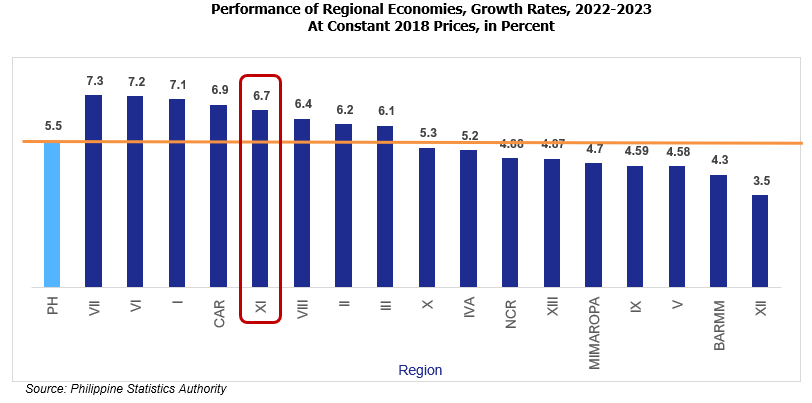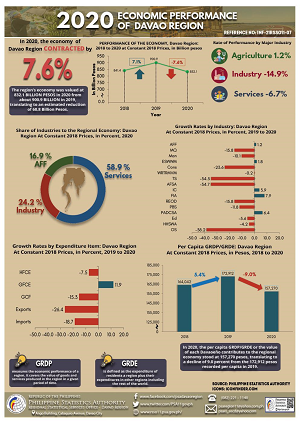Davao Region’s economy posts 6.7 percent growth in 2023
The economy of Davao Region grew by 6.7 percent in 2023, as measured by the Gross Regional Domestic Product (GRDP) and Gross Regional Domestic Expenditure (GRDE). With this growth, Davao Region reached the Trillion Peso economy, joining other big economies like NCR, CALABARZON, Central Luzon, Central Visayas and Western Visayas.
In 2023, the region’s economy was valued at 1.02 trillion pesos from 954.23 billion pesos in 2022, an estimated increase of 63.97 billion pesos.

Performance of sub-industries
All industries positively grew in 2023.
Other services, which includes Arts, Entertainment and Recreation recorded the fastest growth among industries at 21.5 percent. It was followed by Accommodation and food service activities with 16.9 percent and Transportation and storage with
13.2 percent.

Share of Major and sub-industries
Of the 1.02 trillion pesos economy of Davao Region in 2023, Services accounted for 60.9 percent or about 620.08 billion pesos. Industry shared 24.6 percent or 250.94 billion pesos, while Agriculture, forestry and fishing had the least share with 14.5 percent or 147.18 billion pesos.


Of the region’s total Services, which was valued at 620.08 billion pesos, Wholesale and retail trade and repair of motor vehicles and motorcycles industry accounted for the biggest share with 39.9 percent; followed by Financial and insurance activities with 12.3 percent share. Other services accounted for the least share with only 2.1 percent.

Meanwhile, of the total Industry valued at 250.94 billion pesos, Manufacturing had the biggest share, with 44.90 percent; followed by Construction, which accounted for 42.86 percent share; Electricity, steam, water, and waste management accounted for 10.3 percent share; and Mining and Quarrying contributed the least with only 4.0 percent share.

Of the overall 6.7 percent economic growth of the region, 5.1 percentage points came from Services, 1.5 percentage points from Industry, and 0.1 percentage point contributed by Agriculture, forestry and fishing.
Pre-Pandemic Year
During the pandemic in 2020, all industries declined except Agriculture, forestry, and fishing, Electricity, steam, water and waste management, Information and communication, Financial and insurance activities, and Public administration and defense; compulsory social activities.

In 2021, the industries that have surpassed the pre-pandemic level were: Mining and quarrying, Trade, Education, and Human health and social work activities. The following year, Professional and business services added to the industries that have recovered from the pandemic.
In 2023, two more industries (Construction and Accommodation and food service activities) have surpassed their pre-pandemic levels. Only three industries are yet to recover from the pandemic level, these are: Transportation and storage, Real estate and ownership of dwellings, and other services.
Exports of goods and services to Rest of the World records the highest increase in spending in Davao Region
Among the expenditure items in 2023, Exports of goods and services to Rest of the World recorded the highest growth in Davao Region with 12.3 percent. Gross capital formation expanded by 5.9 percent, while household spending recorded a 5.7 percent increase. Imports of goods and services grew by 4.4 percent while the region’s government spending posted an increase of 3.8 percent.

Share of expenditure items to the regional economy
In terms of expenditure shares, household spending made the biggest contribution to the 1.02 trillion pesos regional economy with 64.9 percent followed by gross capital formation with 28.5 percent and Government final consumption expenditure with
10.6 percent.

Contribution of expenditure items to the economic
As to the contribution to growth, Household final consumption expenditure contributed the most with 3.7 percentage points to the 6.7 percent overall economic growth of Davao region in 2023. It was followed by Gross capital formation with 1.7 percentage points, and Net Exports to the Rest of the World with 1.1 percentage points.

Per Capita GRDP
In 2023, the per capita GRDP, or the GDP of every Davaoeño was estimated at 184,074 pesos, translating to an increase of 5.2 percent from the 175,042 pesos recorded per capita GRDP in 2022.

Per Capita HFCE
Meanwhile, the per capita household final consumption (HFCE), or the household spending for every person increased by 4.2 percent from 113,632 pesos in 2022 to 118,353 pesos in 2023.

The region’s per capita HFCE was lower than the national level per capita HFCE of 136,247 pesos.

Performance of Davao Region vis-à-vis other regions
The Philippine economy grew by 5.5 percent in 2023. Eight out of 17 regions nationwide have posted higher rates compared to the rate recorded at the national level. Davao Region was one of these eight regions.
At 6.7 percent growth, Davao Region ranked 5th with the fastest growing economy among the 17 regions in the country in 2023.

Examining the structure of the Regional Economies, no region is predominantly agricultural. One region is predominantly Industrial, that is, Region IV-A CALABARZON. The rest of the regions, including Davao Region are predominantly Services-based.

Economic performance of Davao Region over the years
Since 2001, the economic performance of Davao region was recorded the lowest in 2021 at negative 7.5 percent while the highest was recorded in 2016 at 9.2 percent.

Approved for release:
RANDOLPH ANTHONY B. GALES
(Chief Statistical Specialist)
OIC-Regional Director
PSA XI
Attachment:
Gross Regional Domestic Product_Region XI_by Industry_2000-2023.xlsx
Gross Regional Domestic Product (GRDP) measures the economic performance of a region. It covers the value of goods and services produced in the region, it measures the relative contribution of the three major economic sectors, Agriculture, Hunting, Forestry, and Fishing (AHFF), Industry, and Services.
It is usually reported in terms of growth rate and expressed in real terms or at constant prices. Growth rate shows if the economy grows faster (accelerated) or slower (decelerated) or decline (contracted) compared to the previous period.


